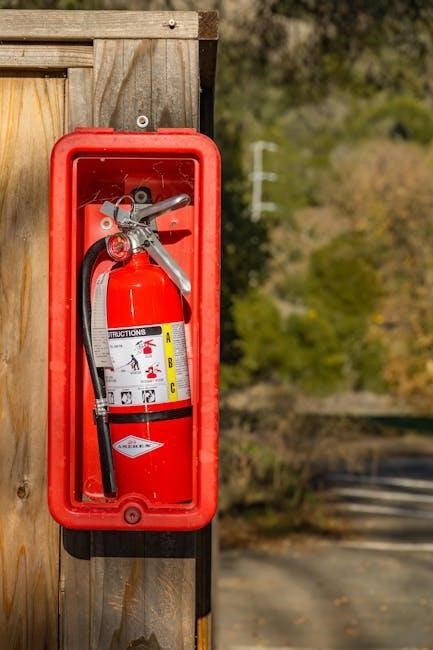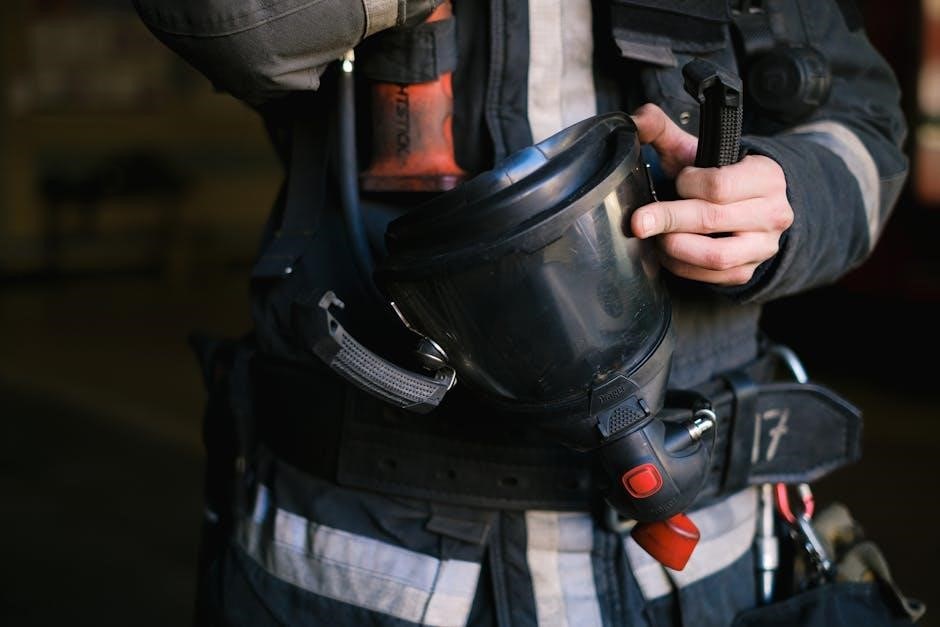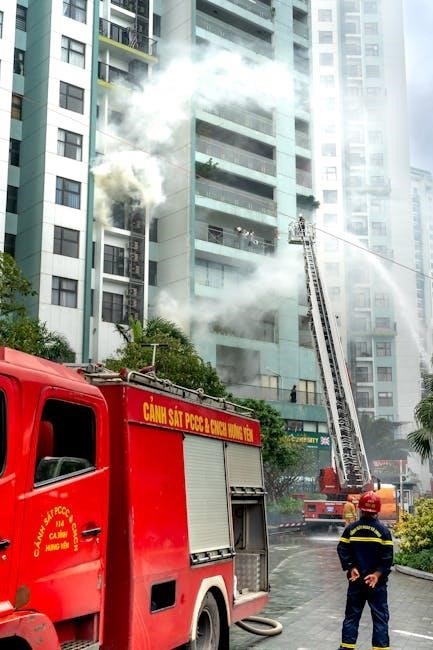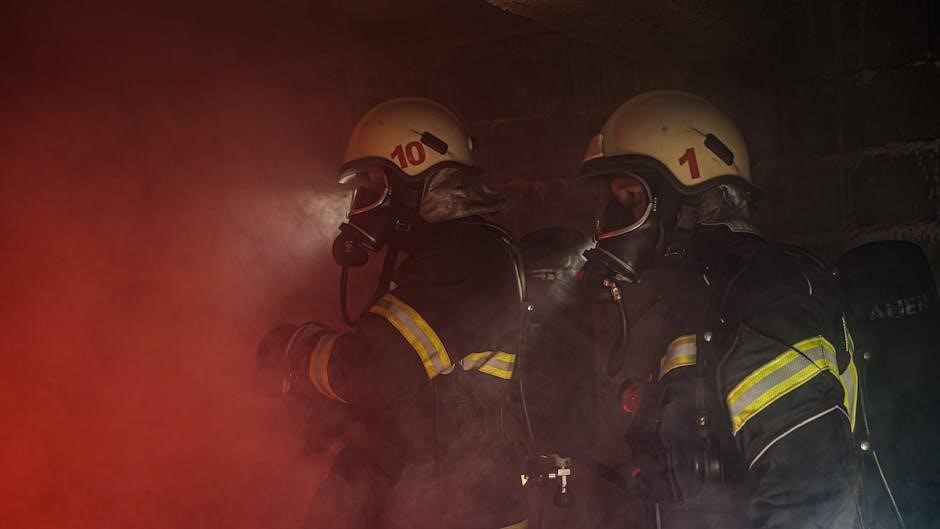The Fire Protection Guide to Hazardous Materials provides comprehensive strategies and standards for safely managing hazardous substances, ensuring effective fire prevention, and emergency response.
1.1 Importance of Fire Safety in Handling Hazardous Materials
Fire safety is critical when handling hazardous materials to prevent catastrophic incidents, protect lives, and minimize property damage. Proper fire safety measures ensure compliance with regulations, reduce risks of explosions or spills, and safeguard the environment. Emergency preparedness and training are essential to respond effectively to fires involving hazardous substances. The NFPA provides guidelines to mitigate these risks, emphasizing the need for adequate storage, ventilation, and emergency response plans. Fire safety also prevents long-term health hazards from toxic fumes and ensures business continuity by avoiding disruptions. Investing in fire safety measures is crucial for industries dealing with hazardous materials, as it protects both people and the environment from potential disasters.
1.2 Overview of the NFPA Fire Protection Guide
The NFPA Fire Protection Guide to Hazardous Materials is a comprehensive resource offering detailed information on fire hazards, safety measures, and emergency response. It consolidates data from various NFPA standards, such as NFPA 30, NFPA 704, and others, providing a unified approach to managing hazardous substances. The guide includes classifications of hazardous materials, fire hazard properties, and best practices for storage, handling, and transportation. It serves as an essential tool for firefighters, emergency responders, and industries dealing with hazardous materials. The guide also emphasizes compliance with regulations and offers practical solutions to mitigate risks, ensuring a safer environment for both professionals and the public. Its structured approach makes it a reliable reference for anyone involved in fire safety and hazardous material management.

Key Concepts in Hazardous Materials Fire Protection
Understanding fire hazards, risk assessment, and mitigation strategies are central to managing hazardous materials. Key properties like flammability and reactivity guide effective fire protection measures.
2.1 Definition and Classification of Hazardous Materials
Hazardous materials are substances that pose risks to human health, safety, and the environment due to their chemical or physical properties. Classification systems, such as the NFPA diamond, categorize these materials based on flammability, health hazards, reactivity, and special risks. This standardized approach ensures consistent identification and handling. Understanding these classifications is critical for developing effective fire protection strategies and emergency response plans. Proper categorization also aids in compliance with safety regulations, ensuring safe storage, transportation, and use of hazardous materials.
2.2 Understanding Fire Hazards and Risks Associated with Hazardous Materials
Fire hazards associated with hazardous materials arise from their chemical and physical properties, such as flammability, reactivity, and toxicity. These risks vary depending on the material’s classification, as defined by systems like the NFPA diamond. High flammability materials, such as volatile liquids, can ignite easily, spreading fire rapidly. Reactive materials may explode or release toxic gases when exposed to heat or flames. Understanding these hazards is crucial for assessing potential risks in storage, handling, and transportation. Proper identification and classification enable the implementation of targeted fire protection measures, reducing the likelihood of incidents and mitigating their impact on people, property, and the environment. This knowledge is essential for developing effective safety protocols and emergency response strategies.

NFPA Standards and Guidelines for Hazardous Materials
NFPA standards provide critical guidelines for managing hazardous materials, ensuring fire safety, and compliance with regulations. They include detailed criteria for storage, handling, and emergency response.
3.1 NFPA 30: Flammable and Combustible Liquids Code

NFPA 30 establishes essential fire safety protocols for flammable and combustible liquids, addressing storage, handling, and use. It ensures compliance with OSHA standards, minimizing fire risks.
3.2 NFPA 704: Standard System for the Identification of the Hazards of Materials
NFPA 704 provides a standardized system for identifying hazards of materials using a diamond-shaped label. This label categorizes hazards into four sections: flammability, health, reactivity, and special hazards. Each section is rated on a scale of 0 to 4, with 4 indicating the highest severity. The system helps emergency responders quickly assess risks during incidents. It is widely used in industrial and emergency response settings to ensure safe handling and mitigation of hazardous materials. The guide includes detailed criteria for rating each hazard category, ensuring consistency and clarity in communication. By following NFPA 704, facilities can effectively label chemicals, enabling rapid decision-making in emergency situations. This system is integral to fire protection and hazardous material management strategies.

Fire Hazard Properties of Hazardous Materials
Fire hazard properties, such as flash point, boiling point, and autoignition temperature, determine the flammability and reactivity of materials, crucial for assessing fire risks and protection strategies.
4.1 Flash Point, Boiling Point, and Autoignition Temperature
Flash point, boiling point, and autoignition temperature are critical properties in assessing fire hazards of hazardous materials. The flash point is the lowest temperature at which a material can ignite, while the boiling point indicates the temperature at which it transitions to vapor. Autoignition temperature refers to the temperature at which a substance spontaneously combusts without an external ignition source. These properties are essential for determining fire risks, storage requirements, and emergency response strategies. Understanding these values helps in classifying materials, designing safe handling practices, and preventing accidental fires. They are fundamental in creating fire safety protocols and ensuring compliance with regulations like NFPA standards. Accurate data on these properties is vital for effective fire protection and hazard mitigation in industrial and emergency settings. Proper interpretation of these values ensures safer handling and storage of hazardous materials, reducing the likelihood of fire incidents and their potential consequences. Additionally, these properties guide the selection of appropriate fire suppression systems and personal protective equipment for emergency responders. Regular updates to these values in safety guides and standards are crucial to reflect the latest research and technological advancements in fire safety. By integrating this information into fire protection plans, organizations can enhance overall safety and minimize risks associated with hazardous materials. These properties are indispensable tools in the ongoing effort to prevent and manage fires involving hazardous substances. Their accurate measurement and application are critical to safeguarding lives, property, and the environment from fire-related hazards.
4.2 Flammability, Reactivity, and Health Hazards
Flammability, reactivity, and health hazards are critical factors in evaluating the risks posed by hazardous materials. Flammability refers to a material’s ability to ignite and sustain combustion, while reactivity indicates how it may react with other substances, potentially leading to dangerous chemical reactions. Health hazards, on the other hand, pertain to the harmful effects of exposure, including toxicity, irritation, or long-term health risks. Understanding these properties is essential for developing safe handling practices, emergency response strategies, and protective measures. For instance, materials with high flammability require specific storage and ventilation protocols, while reactive substances demand controlled environments to prevent unintended reactions. Health hazards dictate the need for personal protective equipment (PPE) and medical preparedness. Together, these factors guide fire protection measures and ensure the safety of personnel and facilities. Accurate classification and communication of these hazards, such as through NFPA 704 labeling, are vital for effective risk management. Proper training and adherence to safety standards minimize the risks associated with hazardous materials, protecting both people and the environment from potential harm. By addressing these three key hazards, organizations can create comprehensive safety plans tailored to the specific risks of the materials they handle. This holistic approach ensures that all potential dangers are mitigated, reducing the likelihood of accidents and enhancing overall fire safety.

Emergency Response to Hazardous Material Fires
Emergency response to hazardous material fires requires immediate evacuation, use of personal protective equipment, and coordination with trained professionals to ensure safe mitigation and containment of incidents.
5.1 Procedures for Responding to Hazardous Material Incidents
Responding to hazardous material incidents requires immediate action to ensure safety and minimize risks. The first step is to evacuate the area and secure it to prevent further exposure; Trained personnel should assess the situation, identify the hazardous material involved, and determine the appropriate response strategy. Using reference materials like the NIOSH Pocket Guide or DOT ERG can help identify the properties and risks of the material. First responders should wear personal protective equipment (PPE) suitable for the hazard level. Communication with emergency services and HAZMAT teams is critical to coordinate efforts. Firefighters and emergency responders must follow established protocols for containment, neutralization, and cleanup. Proper ventilation, use of fire-resistant equipment, and adherence to safety guidelines are essential to prevent escalation. Regular training and drills ensure preparedness for such incidents.
5.2 Use of Personal Protective Equipment (PPE) in Fire Emergencies
Personal Protective Equipment (PPE) is crucial for safeguarding responders in hazardous material fire emergencies. Firefighters must wear heat-resistant and chemical-proof suits, gloves, and boots to prevent skin contact and thermal burns. Respiratory protection, such as SCBA (Self-Contained Breathing Apparatus), is essential to avoid inhaling toxic fumes. Face shields or goggles protect eyes from chemical splashes, while helmets safeguard against falling debris. PPE selection depends on the material’s hazards, as identified by NFPA 704 diamond labels. Proper donning and doffing techniques ensure effectiveness. Regular training on PPE use is vital to prevent equipment failure and ensure responder safety. Compliance with OSHA and NFPA standards guarantees adequate protection levels, reducing risks during hazardous material fires.

Fire Prevention and Safety Measures
Implementing fire prevention measures, such as proper material segregation, ignition source control, and emergency preparedness, ensures a safer environment for handling hazardous materials.
6.1 Storage and Handling Practices for Hazardous Materials
Proper storage and handling of hazardous materials are crucial to preventing fires and ensuring safety. Facilities must comply with NFPA standards, using fire-resistant containers and appropriate storage areas. Materials should be segregated based on their chemical properties to avoid dangerous reactions. Ventilation systems are essential to prevent the accumulation of flammable vapors. Spill control measures, such as containment berms and absorbents, should be readily available. Emergency response plans must be in place, including evacuation routes and communication systems. Regular training for personnel on handling and storage procedures is vital. Proper labeling of materials ensures quick identification in emergencies, while routine inspections help maintain compliance and safety standards.
6.2 Fire-Resistant Containers and Ventilation Systems
Fire-resistant containers are essential for storing hazardous materials, as they prevent the spread of fire and protect contents from ignition. These containers are designed to withstand extreme temperatures and are often used for flammable liquids and gases. Properly installed ventilation systems play a critical role in maintaining a safe environment by removing flammable vapors and reducing the risk of explosions. Explosion-proof fans and vent hoods are commonly used to ensure safe airflow. Regular inspection and maintenance of these systems are necessary to ensure compliance with fire safety standards. Additionally, pressure-relief mechanisms in containers help prevent rupture during thermal expansion. Together, fire-resistant containers and ventilation systems create a layered defense against fire hazards, ensuring the safety of personnel and facilities.

Training and Certification for Hazardous Material Fire Safety
Training programs for emergency responders include hazardous material awareness, operations, and advanced technician-level courses. Certifications ensure compliance with NFPA and OSHA standards, enhancing preparedness and safety.
7.1 Overview of Training Programs for Firefighters and Emergency Responders
Training programs for firefighters and emergency responders focus on hazardous material awareness, operations, and advanced techniques. These programs emphasize understanding fire behavior, chemical properties, and risk assessment. Participants learn to identify hazards using systems like the NFPA diamond, which categorizes flammability, health risks, reactivity, and special hazards. Practical training includes spill control, fire suppression, and the use of personal protective equipment (PPE); Many programs align with NFPA and OSHA standards, ensuring compliance and preparedness. Advanced courses cover incident command, tactical operations, and coordination with other agencies. Regular updates and drills keep responders informed about new hazards and technologies, ensuring they can safely and effectively manage hazardous material incidents.
7.2 Certifications for Hazardous Material Handling and Fire Response
Certifications are critical for ensuring competency in hazardous material handling and fire response. Key certifications include HAZMAT Operations and Emergency Response, offered by organizations like NFPA and OSHA. These certifications validate knowledge of hazard identification, risk assessment, and mitigation techniques. Firefighters and responders often pursue NFPA 472 certification, which covers hazardous materials response. Additional certifications, such as OSHA’s HAZWOPER (Hazardous Waste Operations and Emergency Response), are essential for handling hazardous waste incidents. These programs emphasize practical skills, such as PPE use, spill containment, and fire suppression. Certifications typically require recurring training to maintain proficiency and adapt to new threats. They ensure responders are equipped to handle complex scenarios safely and effectively, protecting both people and the environment from hazardous material incidents.

Case Studies and Real-World Applications
Real-world incidents, like the Morris, Illinois, lithium battery fire, highlight the importance of proper fire protection and emergency response to hazardous material incidents, informing safer practices.
8.1 Notable Incidents Involving Hazardous Material Fires
Several notable incidents highlight the critical importance of fire protection and emergency response in hazardous material fires. For instance, the lithium battery fire in Morris, Illinois, caused dangerous fumes, leading to evacuations and emphasizing the risks of improper handling. Similarly, industrial fires involving hazardous materials near Chicago underscored the need for advanced emergency preparedness. These incidents often result in severe consequences, including environmental damage, health risks, and property loss.
Such events stress the importance of adherence to NFPA guidelines and proper training for responders. Lessons learned from these fires are crucial for improving safety protocols and preventing future disasters. These real-world examples serve as a reminder of the high stakes involved in managing hazardous materials.
8.2 Lessons Learned from Past Fire Incidents
Past fire incidents involving hazardous materials have provided valuable insights into improving safety measures. For instance, the lithium battery fire in Morris, Illinois, highlighted the importance of proper ventilation and emergency response preparedness. Similarly, industrial fires near Chicago emphasized the need for enhanced training and equipment for responders. These incidents underscored the critical role of adhering to NFPA guidelines and conducting regular safety audits.
Another key lesson is the importance of rapid communication and coordination between emergency services and facilities handling hazardous materials. Implementing advanced fire detection systems and ensuring the use of personal protective equipment (PPE) have also been identified as crucial steps to mitigate risks. These lessons serve as a foundation for developing more robust fire protection strategies and training programs.

Legal and Regulatory Requirements
Compliance with OSHA regulations and NFPA standards is essential for ensuring fire safety and handling hazardous materials, preventing penalties and ensuring a safe working environment.
9.1 OSHA Regulations for Hazardous Material Fire Protection
OSHA regulations play a critical role in ensuring fire safety and proper handling of hazardous materials in workplaces. These standards mandate employers to implement fire prevention measures, conduct regular training, and maintain emergency response plans. Specific regulations, such as 29 CFR 1910.120 for hazardous waste operations, outline requirements for personal protective equipment (PPE) and safe practices during fire incidents. Employers must also ensure compliance with NFPA guidelines for storage, handling, and transportation of hazardous materials. Failure to adhere to these regulations can result in severe penalties and increased risks of accidents. OSHA’s framework emphasizes proactive measures to mitigate fire hazards, protecting both workers and facilities from potential disasters. Regular inspections and updates to safety protocols are essential to maintain compliance and safeguard against evolving risks.
9.2 Compliance with Local and International Fire Safety Standards
Compliance with local and international fire safety standards is essential for ensuring the safe handling and storage of hazardous materials. These standards provide a framework for uniform fire safety practices across regions and industries. Organizations must adhere to guidelines set by bodies like ISO, IEC, and local fire authorities to maintain operational safety. International standards often include detailed protocols for fire prevention, emergency response, and hazard mitigation. Certifications and audits are crucial for verifying compliance, ensuring that facilities meet rigorous safety benchmarks. While local regulations may vary, aligning with global standards enhances credibility and operational efficiency. Compliance not only prevents legal penalties but also safeguards lives, property, and the environment from fire-related risks associated with hazardous materials.